
|   |

|   |
Konark Dance Festival 2020 - Tapati Chowdhurie e-mail: tapatichow@yahoo.co.in Photos courtesy: Odisha Tourism December 20, 2020 The five day Konark Dance Festival started in 1986 by Odisha Tourism faced a different set of challenges this year on account of the pandemic. During this time when the climate is salubrious, tourists crowd Odisha like a swarm of honey bees in search of the secrets of Odisha's natural beauty, architectural marvels and above all its deep rooted culture.The festival of dance held in the backdrop of the Konark temple on the banks of the Chandrabhaga went through a major jolt this year. Not many rasikas could attend the festival, though the event was in open air performing space. A regular, yours truly had to decline the invitation to cover the event in person and watch it on DD Bharti instead. The festival's hurdles were many. Recorded music had to be accepted from some groups, troupes of choice couldn't make it for many reasons (who would think of declining the offer to dance in this prestigious venue?), sparse audience, ensuring social distancing, housing artistes - kept the staff and the organizers on their toes, I was told. As usual the festival added as many classical dance forms as was feasible, to provide a glimpse of the varied cultural wealth of the country. Besides Odissi, there was Bharatanatyam, Kuchipudi, Manipuri and Kathak. 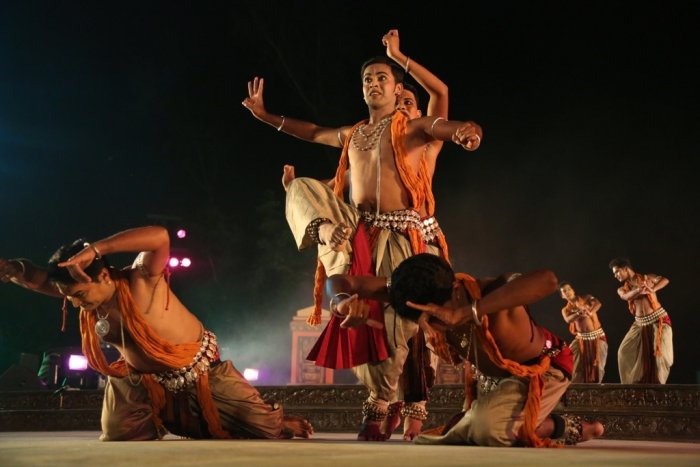 Aruna Mohanty's group Odissi presentation by Orissa Dance Academy of late Guru Gangadhar Pradhan, presently headed by Aruna Mohanty, opened the fest. The group paid obeisance to the lord of dance Nataraja, urging him to destroy all difficulties. Save the world, was their plea. Aruna is always abreast with the times, which invariably is reflected in her productions. Shiva's throat turned blue with the poison of the milk ocean, such is his power of destroying all that is toxic; could he not once again come to mankind's aid in this difficult time? Aruna's fine choreography was enhanced by the composition of rhythm and music by Dhaneswar Swain and Sukanta Kundu to the script of Nityananda Misra. 'Eka Prasna' was a question that has always haunted Aruna Mohanty; it gets reflected in her choreography. Yasoda, Radha, Hidimba and Draupadi sought answers from the divinity, call her or him by any name - in this case Krishna. Through sancharis of the popular stories, the choreographer questions the betrayal and humiliation they went through in spite of their sacrifices. Aruna Mohanty has used the past to shed light on the present. Her questioning mind contemporized the past, and using the language of Odissi, she articulated on contemporary issues using mythology as her aid. Music for this piece was composed by the talented Agnimitra Behera, with script inputs by Kedar Mishra. Vocalists Nazia Sayeed and Rupak Parida and violinists Ramesh Chandra Das and Agnimitra Behera impressed. Dancer Madhusmita Mohanty has been carefully nurtured by her guru to stand out as a performer. 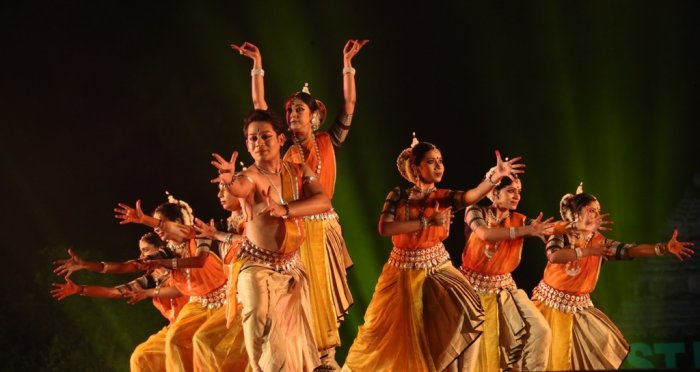 Sanjali Ensemble Sanjali Ensemble from Bangalore headed by Odissi exponent Sharmila Mukerjee invoked god Surya, the son of Kashyap Muni according to mythology, the dispeller of darkness and giver of life. The sun's journey from the east to the west was vividly traced by her well trained repertory. Armed with the powerful script of Pt Nityananda Misra, composition of Bijoy Jena, and rhythm by Bijay Barik, Sharmila Mukerjee's choreography sailed through smoothly. Jhinjhoti Pallavi followed by Shisira Geetham capturing the mood of winter from Kalidasa's Ritusamhara with its motifs of bird song, green fields, joyful and yearning lovers etched in variety of ragas and talas created an aura. Moksha in raag Bhairavi and taal ektali - a Kelucharan Mohapatra composition - was in the fare. Performing in the prestigious Konark Festival is a bright feather in her cap, richly deserved. 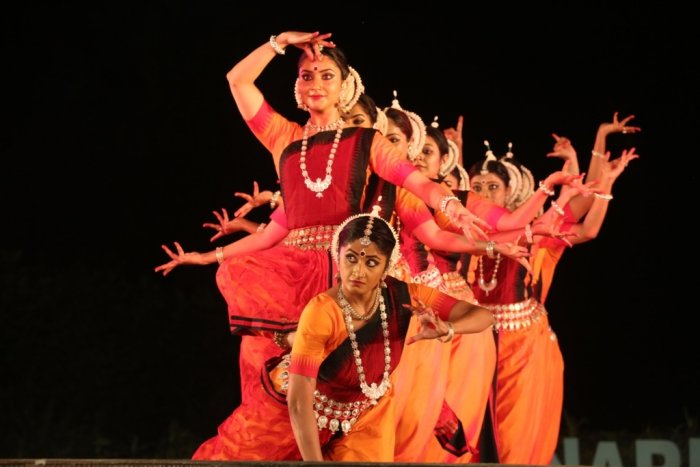 Madhulita Mohapatra's group Bangalore based Odissi dancer and an illustrious disciple of Aruna Mohanty, Madhulita Mohapatra presented her Nrityantar group choosing to sing in praise of Devi in the piece Ishwari to a music composition by Sukanto Kundu. Pt Nityananda Misra with his immense wealth of knowledge of our mythology, helped Madhulita to portray the three popular forms of Devi - Manikeswari, Chamundeswari and Durgeswari. Opening of the piece with rhythmic bols of nishan, dhol and ghanta - musical instruments used in traditional Sambalpuri folk music - for Devi Manikeswari was appropriate, because she is the presiding deity of the region, taken from the Chhatar Jatra procession of Kalahandi interspersed with energetic passages exploring fierce attributes of Devi Chamundeswari and Durgeswari, culminating in the latter killing Mahishasur. Madhulita and her disciples presented the beauty of Malhar Pallavi choreographed by her. She chose to perform Varsha Avisar from Kalidasa's Ritusamharam. This particular piece choreographed by Aruna Mohanty was rich in portraying the splendour of the seasons, showing the monsoon in its myriads of manifestations bringing happiness to the romantically inclined. Its fierce beauty is no less fascinating. Guru Ramahari Das and Guru Dhaneswar Swain wove beauty through their music and rhythm. Purandara Dasa's devarnama "Hari smarane mado niranthara" urged devotees to meditate on Hari for salvation. For the sanchari bhavas the choreographer incorporated the popular story of Krishna's rescue of the elephant from the clutches of the crocodile and the story of Narasimha avatar. It was a neat presentation. 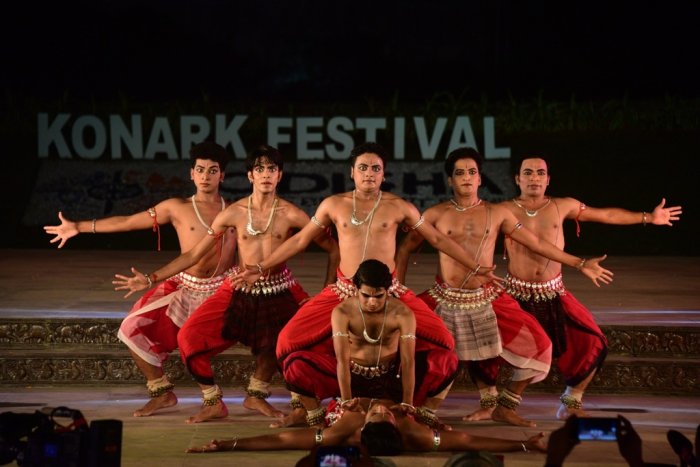 Rudrakshya ensemble Bichitrananda Swain, the Artistic Director of Rudrakshya Foundation, presented his all male dancers team in two of his classy choreographies executed immaculately. "Jaha Krishna Saha Kali" delved deep into the concept of Krishna and Kali in exploration of the similarities and contrasts between the two. It was an unusual beginning with a devotee meditating with the OM sound and the bija mantras of Kleem and Kreem for Krishna and Kali respectively, Krishna with gopis on the banks of Yamuna and Kali with howling jackals in the cremation ground. Several similarities and dissimilarities made for a spectacular dramatic delineation, with the scope to perform eye-catching formations and powerful dance capturing the attention of the audience from start to finish. The shringara leela between these contrasting characters oblivious of Radha and Shiva - their partners - signifying the merging of Krishna and Kali was wondrous. The second piece Chakravyuha was taken from the great battle of Kurukshetra. Chakravyuha is a war formation requiring skill to break through, which was known only to Arjuna and partly to Abhimanyu who did not know the skill of coming out of the formation. The story of the circumstances that led Abhimanyu to access it is a hair raising story of the Kaurava army headed by Guru Dronacharya martyring the boy warrior jointly. Music composition by Ramahari Das and rhythm composition of Dhaneswar Swain was of a high standard. Light designer Debi Prasad Misra made the two works come alive. 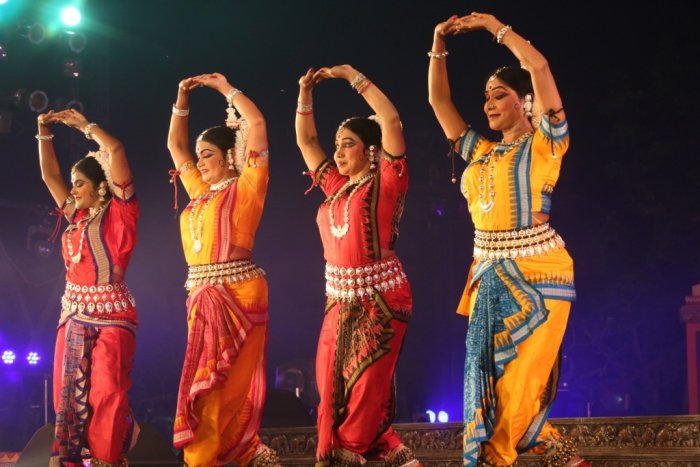 GKCM Odissi Research Centre Expectations from GKCM Odissi Research Centre's presentation ran high, but what one got to see were performers from yesteryears who are out of practice. Sujata Mohapatra who led the group was the only one who is an active performer. Even if former students of the institution had to be accommodated, why did Kasturi Pattanaik who arranged the dances not take students who are performers. The dance pieces performed after Surya Vandana were Shankarabaranam Pallavi and Krishna Gatha. Known stories of Krishna's life were strung in a beautiful garland. A Pallavi displaying pure nritta is perhaps made for vibrant dancers, to avoid puffing and panting. In that respect Krishna Gatha with scope for abhinaya was a good choice. A powerful group of musicians supporting the performance gave it the much needed uplift. Sangita Gosain and Kshiti Prakash Mohapatra's vocal rendition augured excellence. Satchidananda Das, Buddhanath Swain, Swapneswar Chakraborty and Ramesh Chandra were the other able supporters. 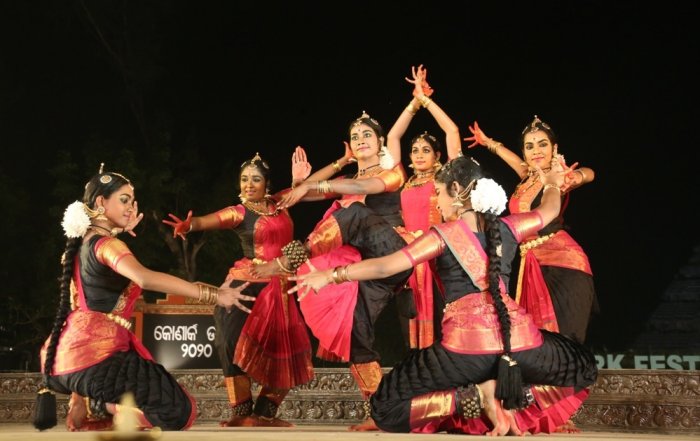 Sridevi Nrityalaya Sridevi Nrityalaya under the mentorship of Guru Sheela Unnikrishnan presented with her team of eight dancers the Melattur bani of Bharatanatyam, which has its own distinctive style. Clad in combination of black and shocking pink costume and bejewelled traditionally, they danced Sivaya Namah in the style of Mangudi Dorairaja Iyer, the founder of the Melattur style. The invocatory piece was an Alarippu with an interesting rhythm composition, the hallmark of the style, specially composed by Dr. Guru Bharadwaj that had a recurring cycle of tisra, khanda, misra and sankirna chapu taalas that blossomed beautifully. While the Alarippu was being performed Sanskrit verses of Ganesha, Surya and Shiva were recited in the background. This was quite a novelty giving the Alarippu its richness. A composition of Papanasaam Sivan, "Swami naan undhan adimai" set to Naatakurinji in adi talam was next. It was the yearning heroine desiring to be with her lord Shiva performed in group. The boon of life received by Markandeya, a great devotee of Shiva was skillfully enacted in the sanchari bhava. The famous Swati Tirunal composition "Shankara Srigiri natha prabho" describing the cosmic dance of Shiva in ragam Hamsadhwani and adi talam was a good choice executed in the typical Melattur style of using bhakti bhava in shuddha nritta. Mangalam was the concluding piece which again saw devotees paying their obeisance to Shiva, the destroyer of Tripurasuras, in ragam Navroj and tisra nadai, adi by Balamuralikrishna. The open air stage of Konark is in two tiers with the intention of making the presentations spectacular by spreading out in varied formations using both levels, which would have given the impression of the dancers sculpted on the temple walls come alive on stage. The choreographic work fell short here. The performers stuck to one level only. 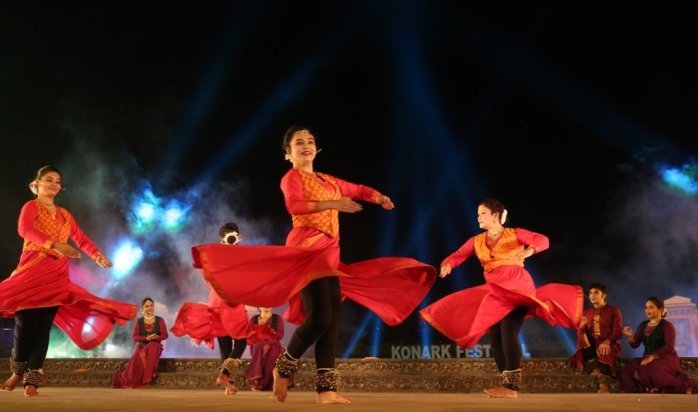 Ranan Ranan founded by Vikram Iyengar and Debasree Bhattacharya, both disciples of Rani Karnaa, presented Vaichitra on the 4th evening of the festival. Vaichitra was a gem from the repertoire of Kathaka Rani Karnaa. A collage of pieces both pure and expressional woven together exploring various talas and ragas of Hindustani classical music creating spatial designs and expanding the boundaries of movement provided a glimpse of the richness of Kathak. Sanyog Shringar was the love dalliance between the eternal pair of lovers Radha and Krishna at Vrindavan. It blended sahitya, sargam and chanda aesthetically inclusive of the techniques of bol, paran, tihai and gat bhav. A verse from Rati Keli Mimasa authored by Swami Haridas provided the text. The music in raag Kedar and teentaal was by Rajkumar Rizvi. The beauty of the heavenly dance in the verdant ground where flows the Yamuna, had a rejuvenating effect. Debasree and Sohini transported you to a world of beauty. Rudra Taal of 11 beats in the medium pace was followed by teentaal of 16 beats, culminating in coming together of pure dance and abhinaya in Krishna Chakradharam - a sool taal composition of 10 beats describing Krishna on the battlefield of Kurukshetra wielding his Sudarshan Chakra, causing the earth to tremble and the heavens to spit fire, the lyrics of which was by Dr. S. Saxena performed by Vikram Iyengar and his group. With the Sun Temple in the background, they invoked Surya chanting the Surya Ashtakam. Ranan presented an evening of beauty and bliss. 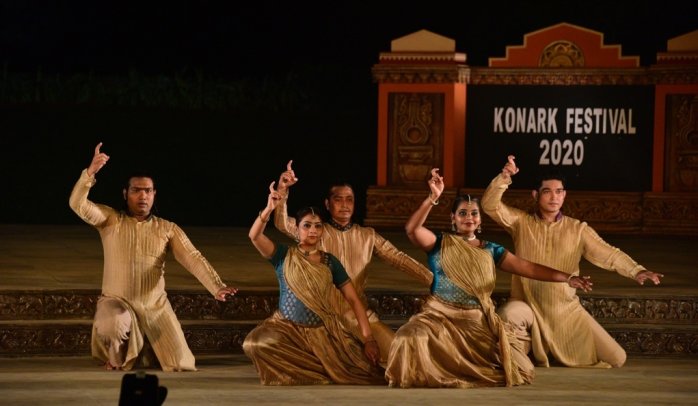 Drishtikon ensemble Kathak was presented by Drishtikon on the final day of the festival. The group was led by Aditi Mangaldas' talented disciple Gauri Diwakar. Ganesh stuti was the starting piece, which ended with several visions of Shiva. Fida -the celebration of love, was a jaw dropping abstract piece, with both male and female dancers immersed in the joy of movement, swirling like dervishes, practised movements easing them from every kind of consciousness, reveling in uniting with the lover in dance. Periods of silence were eloquent. Though a small group of dancers, they made an impact. Samiulla Khan's music complemented the performance. 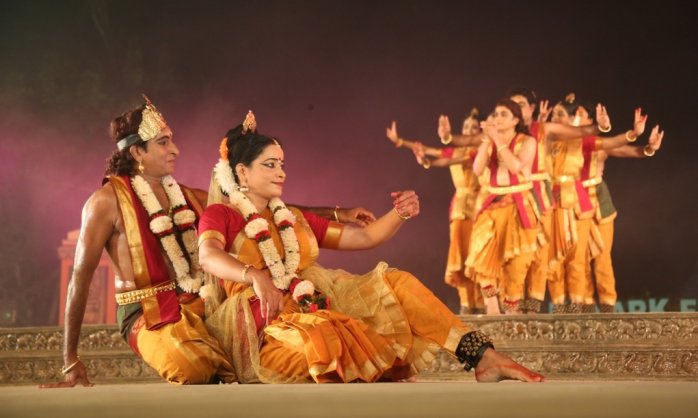 Vasantalakshmi Narasimhachari's group In Kuchipudi dance the custom of taking the blessings of the guardian angels of all the eight directions is followed to this day. And so it was with the troupe of Vasantalakshmi Narasimhachari from Chennai. They commenced their recital with Shiva Leela covering three episodes from Shiva Purana - Ksheera Sagara Manthanam, Manmatha Bhangam and Ananda Tandavam. Since Kuchipudi dance is essentially a dance-drama tradition there was an abundance of theatrical exuberance, dramatization and nuanced abhinaya and powerful characterization, set to the accompaniment of engaging lyrics and lilting music. What seemed loud to a modern audience used to minimalism is its adherence to the parent body of Kuchipudi inspired dance-drama of Andhra. Lasya Mavilapalli did well as the lead dancer. 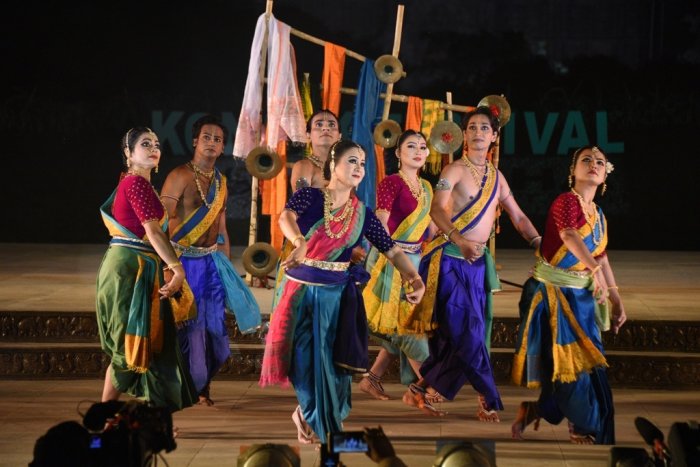 Bimbavati Devi's group Ghana Bari Barikhata - Reflection in a raindrop - by Manipuri exponent Bimbavati Devi offered us a brief glimpse of Manipur, its traditions and rituals, its deep cultural roots, its ethnic high pitched singing style. Ghana Bari Barikhata is a traditional song from Attalika Darshan, a part of Nata Sankirtana community prayers. It speaks of Radha's yearning, tears streaming down her cheeks like torrential rains, when she sees her lover Krishna walking past with his sakhas. The choreographer has examined the meaning and its underlying philosophy from various angles before embarking on her project. The monsoon or the rains have been personified and is much awaited by not only birds like the chataka and chakravahana, but also by young dancing girls, minstrels and poets who pen verses on it. Happily Bimbavati indulges in Valmiki's varsha varnan - Varsha ritu is in fact the story of every man. The portion when the nayika - be it Radha or anybody else longing for her lover - is apprehensive of meeting him on a stormy night which is fraught with danger, she takes the positive step to be ready for any contingencies. She walks on thorns and slippery paths, blindfolds herself to face a foggy night and so on and when she actually embarks on such a journey, an angel unknown to her places her hand below her feet, spreads her hair in the pathways to make her journey smooth; causes lightning to happen to help brighten her way to reach the happy moment when her individual soul merges with the supersoul. Both Jhulan and Rath Yatra happen during the monsoon and the appropriateness of showing these two seasons is unquestionable. Krishna comes down to visit his devotees in a clean earth washed by the rains, through his divine intervention. Mortals and the immortal unite in dance. Dasavatar in the Manipuri language is sung. Bimbavati conceptualized, choreographed and directed this enthralling piece to the music composition of N. Tiken Singh.  Tapati Chowdurie trained under Guru Gopinath in Madras and was briefly with International Centre for Kathakali in New Delhi. Presently, she is a freelance writer on the performing arts. |